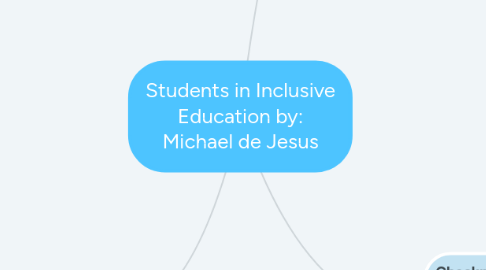
1. Offer Support
1.1. IEP's
1.1.1. Set students up for success
1.1.2. Instructional accommodations
1.1.2.1. Peer tutoring
1.1.2.2. Note-taking assistance
1.1.2.3. Extra time to work
1.1.2.4. Recorded texts
1.1.2.5. Manipulatives/computer access
1.1.2.6. Rephrasing/repetition of information
1.1.3. Environmental accommodations
1.1.3.1. Alternative work space
1.1.3.2. Strategic seating
1.1.3.3. Close proximity to istructor
1.1.3.4. Quiet setting
1.1.3.5. Assisstive devices/adaptive equipment (e.g. tablets with educational apps)
1.1.3.6. Use of earphones
1.1.3.7. Reduction of audio/visual stimuli
1.1.4. Assessment accommodations
1.1.4.1. Extended time
1.1.4.2. Assistive tech (e.g. speech-to-text software)
1.1.4.3. More frequent breaks
1.1.4.4. Oral responses, one-on-one presentations
1.1.4.5. Uncluttered formatting of tests/assignments
1.2. Universal Design for Learning (UDL)
1.2.1. Provide multiple means of:
1.2.1.1. Engagement
1.2.1.1.1. The "WHY" of learning
1.2.1.1.2. Minimize threats and distractions
1.2.1.1.3. Encourage collaboration/community
1.2.1.2. Representation
1.2.1.2.1. Offer options of displaying info
1.2.1.2.2. Offer alternatives for auditory/visual info
1.2.1.2.3. Clarify vocabulary, symbols, syntax and structure
1.2.1.2.4. Supply enough context and background knowledge
1.2.1.3. Action & Expression
1.2.1.3.1. The "HOW" of learning
1.2.1.3.2. Optimize access to tools and assistive technologies - provide support to use tools effectively
1.2.1.3.3. Provide alternative modalities for expression - to learn composition, and not just writing with pen/pencil and paper
1.2.1.3.4. Scaffolding - learners have access to knowledge
1.2.1.3.5. Highlight or emphasize key elements in text, graphics, diagrams, formulas for students to better understand the content
2. Build a Positive Atmosphere
2.1. Promote sense of belonging
2.2. Progress toward all students' personal, emotional, social and academic goals
2.2.1. Educators are sensitive and adaptable to individual learning needs
2.2.2. Provide exceptional support and apply student-centred teaching practices and principles
2.2.2.1. "[I]t is . . . unlikely to take up experiences of gender and race without also reflecting on the perceptions of ability that are constructed through gendered and racialized notions of what constitutes an ‘able-body’ or ‘able-mind’. In addition, class cannot be dismissed as an isolated experience, separate from experiences of gender, race, and ability" (Parekh, 2018).
2.2.2.2. Students who are considered 'mentally/physically disabled' have the same access and privileges of education as those who are constituted as 'able-bodied/minded'
2.3. Establish a common learning environment
2.4. students with different backgrounds and abilities learn together in an inclusive environment
2.5. this is not a place where students with intellectual disabilities/other special needs learn in isolation from their classmates
3. Checkpoints for Inclusive Learning
3.1. Educate for a better future
3.1.1. Education prepares young students to discover their purpose in the world, and to create a positive future for themselves
3.1.2. Live sustainably, respect the environment
3.1.3. Encourage cooperation amongst peers, embrace their talents and creativity
3.2. Promote inclusion
3.2.1. Be concerned on how every student can benefit by learning and cooperating with others
3.2.2. Ensure that those with disabilities and other special needs are educated in the same classrooms with their age
3.2.3. Ensure that the school respects all diversity and welcomes everybody
3.3. Prioritizing inclusive pedagogy
3.3.1. Always have differentiated lessons so that all students are able to participate
3.3.2. Promote cooperative learning by grouping students
3.3.3. Students should always have peer support
3.3.4. Great teachers know how each student learns best, and accommodates them based on their abilities and learning styles

